Do-it-yourself well warming for the winter: an overview of the best materials and methods of warming
Freezing a well is a very unpleasant event for residents of country houses who use well water for water supply all year round. Avoiding this is simple enough - to make the well warm with your own hands. And for a positive result, you need to know the specifics of performing thermal insulation and understand the materials. Do you agree?
We will tell you how to correctly choose a heater for thermal insulation of a well mine. Here you will learn all about the methods and nuances of the work. Based on our recommendations, you can ideally protect the water source from exposure to low temperatures.
The content of the article:
Reasons for freezing wells
Will the well freeze in winter? This can be predicted with a high degree of probability.
Firstly, if a natural tree was used for the construction of the well, it will not freeze even with prolonged exposure to subzero temperatures. Our ancestors used this property when constructing wood wells.
Modern wells are constructed using reinforced concrete rings, and given that this material has high thermal conductivity, the well will freeze in the same way as the surrounding soil.
Secondly, it is necessary to pay attention to the water level: if it does not exceed 1.1-2.2 m, then the risk of freezing is very high. If the well is deep, and the water in it is below the level of soil freezing, then water does not freeze.
The third factor to consider is the depth of soil freezing in the region. In the southern regions, the freezing depth rarely exceeds 0.5 m, in the temperate - 1-1.5 m, in the north - below 1.5 m.
Thus, the question of how to properly insulate a well for the winter confronts the owners of reinforced concrete wells located in temperate and northern climates. For residents of the southern regions, it is less relevant.There are enough minimal measures - the construction of a heat-insulated cover, and the well itself does not need thermal insulation.
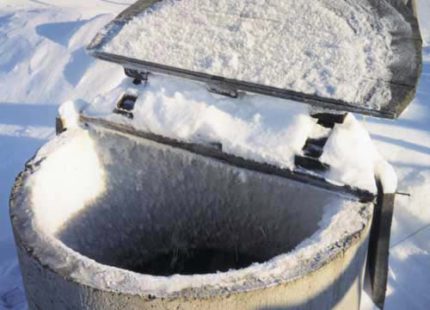
Why is freezing a well dangerous?
It is a mistake to assume that the insulation of wells is necessary only when it is used year-round. Many summer residents and seasonal residents of country houses sincerely do not understand why to insulate a well, which no one uses in winter anyway. And meanwhile, such seasonal wells also need effective thermal insulation!
Otherwise, a variety of problems may arise that make the operation of the well difficult or completely impossible:
- ice plug formation in the water system;
- the displacement of the rings resulting from the expansion of frozen water in the surrounding soil;
- failure of the ice plug and damage to pumping equipment;
- the divergence of the joints of reinforced concrete rings when water gets between the seams.
Wells unprotected from low temperatures often require repair work. And for financial costs, repair measures are often more significant than conducting one-time insulation work.
If a water supply system based on a well is arranged in a suburban area, then in addition to the mine itself, it is required insulate pipes to protect the system supply line from low temperatures.
Materials and work technology
It is necessary to take care of the insulation of a reinforced concrete well at the stage of its construction.
In this case, you will immediately receive a source of water supply that you can use all year round, and which does not require expensive repairs. Thermal insulation during the construction process will cost you much cheaper, and the amount of earthwork will be less.
If the well, which has already been built and is in operation, needs insulation, then a sufficiently large-scale excavation is necessary - digging a trench around the well shaft for fastening the insulation. Installation of insulation should be carried out at 0.5-1 m below the level of soil freezing.
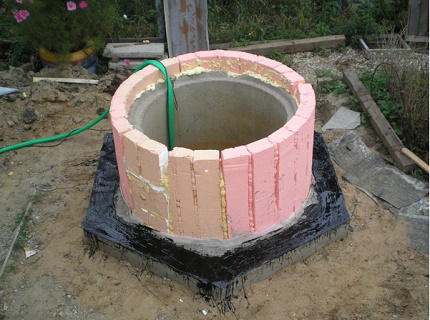
We will analyze what heat-insulating materials can be used for wells built from reinforced concrete rings.
Heater # 1 - Styrofoam
Polyfoam is a synthetic polymer thermal insulation used for warming reinforced concrete wells, both under construction and already existing.
The advantages of foam include:
- high thermal conductivity;
- low degree of water absorption;
- resistance to deformation;
- ease of use;
- low cost in comparison with other heaters.
One of the main advantages of the foam is that it is available in the form of a system of insulation for round and semicircular elements, ready for the device, whose diameter exactly matches the dimensions of the reinforced concrete well rings.
This greatly simplifies the process of insulation, which is carried out according to the following technology:
- Preparing the walls of the well for fastening the insulation. Preparation consists in cleaning the surface of debris, soil and other contaminants.
- Installation of thermal insulation (rings, half rings or individual insulation plates) with the help of glue applied to them for facade work.
- Strengthening the fastening of foam rings with special dowel nails for concrete. It is carried out if necessary.
- The device of the vapor barrier. Any vapor barrier material is suitable here.
- Filling the trench around the well with soil, compaction and tamping.
As you can see, there is nothing complicated in the technology of thermal insulation using foam. However, it is worth noting that, in addition to the advantages, the described thermal insulation has some disadvantages.

Polyfoam is unstable to the effects of insects and rodents, and low-quality samples of it can release toxic substances into the environment when heated when heated, styrene, which poison the soil and the upper layers of the soil.
Insulation # 2 - extruded polystyrene foam
This insulation resembles polystyrene in properties, but has some differences: slightly lower thermal conductivity, higher resistance to low temperatures and aggressive environments. The material perfectly withstands the load, so it is widely used in the construction of underground pipelines.
For thermal insulation of the well, extruded polystyrene foam of the following brands can be used: Technoplex, Tenziplex, actively in demand in construction Penoplex, URSA Russian production.
Imported analogues will be identical in properties and quality to Russian ones, but at a cost significantly higher. By the way, thermal insulation based on extruded polystyrene foam is 20-30% more expensive than foam insulation.
Expanded polystyrene heaters are available in the form of plates of various sizes. For wells, it is recommended to use slabs with a minimum transverse size of 30 cm, which can most accurately be laid in a circle in the shape of the well. The technology of the insulation system is exactly the same as with thermal insulation foam.
The resulting joints must be sealed with foam for outdoor use. To ensure a snug fit and additional protection against groundwater, a winding of the insulation installed on the reinforced concrete rings is made with a roll of waterproofing material.
The advantages of using extruded polystyrene foam include:
- does not deform under the influence of loads (soil layer);
- resistance to mold, corrosion;
- durability, retains thermal insulation properties for more than 25 years.
When warming the outer part of the well, located above the surface of the earth, it is advisable to fix the insulation with special metal brackets to prevent its movement.
The process of warming a well mine in steps will be presented by the following photo selection:
Heater # 3 - cellular polymeric materials
Materials belonging to the group of closed-cell insulation based on a polymer basis have found the widest application in construction. Due to its properties: high characteristics of thermal insulation, resistance to moisture, ductility, these heat insulators are increasingly used for warming reinforced concrete wells.
One of the types of polymer insulation with a cellular base is isolon. Its analogs are also presented on the construction market: plex, isonel, tilite, foam rubber, etc. These materials are produced in the form of rolls, which allows thermal insulation of round reinforced concrete wells without problems.
Most materials in this group are self-adhesive, i.e. do not require additional fastening to reinforced concrete walls.
The technology of insulation with isolon or its analogues is as follows:
- Surface preparation of the outer walls of the well.
- Processing reinforced concrete rings with a special primer that improves the adhesion of concrete and insulation.
- Gluing the isolon with glue for outdoor use (if the material is not self-adhesive).
- Sizing joints with duct tape.
- Backfilling of the trench and compaction of the soil.
The group of cellular mineral-based heat insulation materials includes foamglass produced by foaming silicate chips under special conditions. Such a heater has good thermal insulation, is environmentally safe, easy to use, but its too high cost does not allow it to be used for thermal insulation of wells.
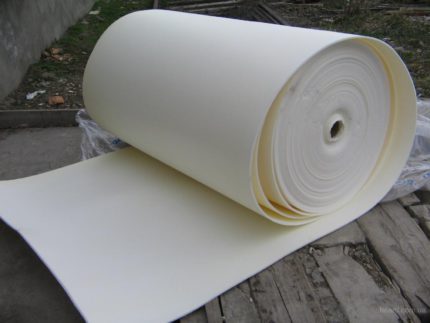
Heater # 4 - polyurethane foam
Polyurethane foam - a heater with unique properties: high thermal insulation, resistance to humidity and aggressive environments, it is not susceptible to insects. The service life of polyurethane is at least 50 years!
Today, manufacturers offer two types of polyurethane foam insulation: ready-to-use, sold in special containers, and in the form of a dry mixture that requires dilution before use. Polyurethane foam is applied to the surface using special spray equipment.
The technology for creating a thermal insulation system is as follows:
- Surface preparation and priming.
- Dilution of polyurethane foam mixture in accordance with the manufacturer's instructions.
- Application of polyurethane insulation using a special spray.
- Painting the aboveground part of the well with paint for outdoor use.
Polyurethane foam has optimal thermal insulation properties, and the method of application in the form of spraying allows you to create a durable thermal insulation layer without seams and joints. The applied composition hardens within a few minutes, and the final hardening occurs after 4-5 hours.
The disadvantage of this method is the high cost of the material, polyurethane foam is one of the most expensive insulation, as well as the need for special spray equipment. Another drawback - to apply insulation is necessary only in the temperature range from +15 to +30 degrees.

Why can not you use mineral wool?
Many people wonder how to better insulate winter water well with the help of such a popular insulation as mineral wool. The answer to it is simple: categorically it is impossible to warm a well with mineral wool!
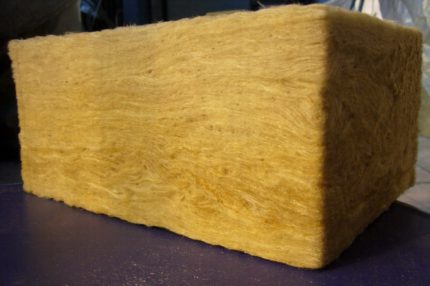
Having good thermal insulation properties and low price, this insulation, however, has an important significant drawback, which makes its use for thermal insulation of wells impossible.
We are talking about the ability of a material to absorb water from the environment. Therefore, the parameter mineral wool is a “leader”, it quickly absorbs moisture, while losing its heat-insulating qualities.
Well cover and wooden house
To ensure the best protection of the well from freezing, in addition to warming the well shaft, it is also necessary to carry out external insulation work. They consist in the device and insulation of the well cover and / or the construction of a wooden house above the well.
The cover for the well must be installed taking into account the maximum water level. The movement of the cover is provided with a cable or rope. The best material for making the lid is wood. Also, a three-layer cover of two layers of thick plywood with a heater between them will be an excellent option.
As a heater, it is advisable to use expanded polystyrene or polystyrene.
If you decide to use a well cover made of reinforced concrete, then it also needs to be insulated by attaching a layer of polystyrene or other insulation. Fastening is carried out using glue for external works and the expansion bolt shield nails for concrete.

Installing a house over a well is a more expensive way, however, it has its advantages:
- reliable shelter of a well shaft from hit of garbage, rainfall;
- the ability to use the well in any weather (rain, strong wind);
- aesthetic appearance, a wooden house is perceived as an element of landscape design.
You can make such a wooden house yourself or buy a ready-made version. In any case, it is worth knowing that the house is not installed just on the surface of the earth. He needs a foundation, which is performed as follows: the area around the well is leveled and a blind area is made, onto which a layer of small gravel is poured or tiles are laid.
After that, a wooden house is mounted, and the space between it and the reinforced concrete ring is filled with insulation. In this case, expanded clay can be used as insulation - an inexpensive bulk material.
Conclusions and useful video on the topic
Video # 1. Insulation of the well with foil isolon:
Video # 2. Creating thermal insulation by spraying polyurethane foam:
In our climate, insulation of a reinforced concrete well is a necessary measure, even with seasonal use. The cost of carrying out insulation work will pay off in the shortest possible time, because you will no longer have to carry out expensive repairs of the well and organize the supply of water when it is not working.
The choice of thermal insulation materials in the modern market is large and you will surely find the option that is optimal for you in the installation method and at a cost.
Do you want to tell about your own experience in warming a well shaft or provide useful information? Perhaps, during the familiarization with the proposed information, you had questions? Please write comments in the block below.

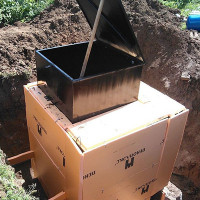 How to warm a well for the winter: an overview of the best ways + material selection
How to warm a well for the winter: an overview of the best ways + material selection  Digging a well with your own hands: types of well structures + an overview of the best digging technologies
Digging a well with your own hands: types of well structures + an overview of the best digging technologies  Do-it-yourself deepening of the well: a review of the best methods to get to the aquifer
Do-it-yourself deepening of the well: a review of the best methods to get to the aquifer  Do-it-yourself well cleaning: a review of the best preventative and capital methods
Do-it-yourself well cleaning: a review of the best preventative and capital methods 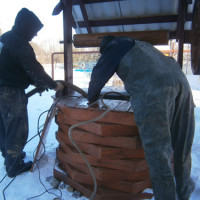 Water purification from a well: an overview of the best and most effective ways
Water purification from a well: an overview of the best and most effective ways 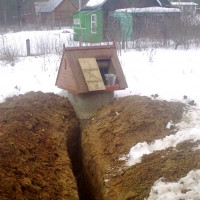 Winter water supply from a well: an overview of the best options and arrangement schemes
Winter water supply from a well: an overview of the best options and arrangement schemes  How much does it cost to connect gas to a private house: the price of organizing gas supply
How much does it cost to connect gas to a private house: the price of organizing gas supply  The best washing machines with dryer: model rating and customer tips
The best washing machines with dryer: model rating and customer tips  What is the color temperature of light and the nuances of choosing the temperature of the lamps to suit your needs
What is the color temperature of light and the nuances of choosing the temperature of the lamps to suit your needs  Replacement of a geyser in an apartment: replacement paperwork + basic norms and requirements
Replacement of a geyser in an apartment: replacement paperwork + basic norms and requirements
All of the described methods relate to the time of construction of the well. If the well is old, that is, it already exists, then only the construction of a house above it is suitable. If this is a new well based on a well, then it is unlikely that the water in it will freeze, so the wells are rather deep structures. So, maybe you should not bother with complex and expensive insulation?
It's all about the depth of the well and the depth of freezing of the soil. Usually not deep wells quite often freeze in winter, and this already entails consequences that will cost several times more than preliminary insulation. Rings may burst, structural integrity may be impaired, and groundwater may enter.
Of course, the article describes the options for warming the well directly in the process of laying the rings, but the option with warming the head can be implemented for the finished well. It’s not too expensive for money if you do all the work yourself by purchasing the necessary building materials.
Especially relevant for those who use water from a well all year round for water supply. Since if the water in the well freezes, then internal communications can also be damaged.
At the mother-in-law in the village in the courtyard of the house there is an old well, now they have already crashed into a public sewer, and they rarely use it. Nobody is going to warm it, the house with a lid on top stands, so it still freezes every winter, because it is shallow and the water is at the level of freezing of the soil layers. We live in the middle lane. For neighbors, the pipeline from the well runs shallow from ground level, so as not to suffer in winter, they wrapped it with a heating cable.